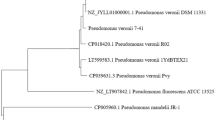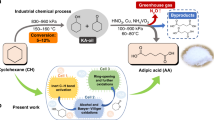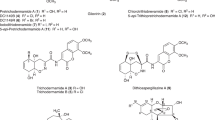Abstract
We have identified a strain of Pseudomonas mendocina that oxidizes trichloroethylene (TCE) after growth in the presence of toluene. A DNA fragment from this organism, when introduced into the appropriate expression vector system, conferred upon Escherichia coli the ability to oxidize both toluene and TCE. The recombinant E. coli rapidly degrades TCE to carbon dioxide, chloride ion and simple water soluble metabolites and reduces the concentration of TCE in water as much as 1000–fold. The extensive degradation of TCE by the recombinant E. coli is due to genetic manipulations that uncouple the regulation of TCE degrading enzymes from growth and co metabolism of toluene.
This is a preview of subscription content, access via your institution
Access options
Subscribe to this journal
Receive 12 print issues and online access
$209.00 per year
only $17.42 per issue
Buy this article
- Purchase on Springer Link
- Instant access to full article PDF
Prices may be subject to local taxes which are calculated during checkout
Similar content being viewed by others
References
Miller, R.E. and Guengerich, F.P. 1982. Oxidation of trichloroethylene by liver microsomal cytochrome P-450: Evidence for chlorine migration in a transition state not involving trichloroethylene oxide. Biochemistry 21:1090–1097.
Bouwer, E.J. and McCarty, P.L. 1983. Transformation of 1- and 2-carbon halogenated aliphatic organic compounds under methanogenic conditions. Appl. Environ. Microbiol. 45:1286–1294.
Kleopfer, R.D., Easley, D.M., Haas, B.B., Deihl, T.G., Jackson, D.E., and Wurrey, C.J. 1985. Anaerobic degradation of trichloroethylene in soil. Environ. Sci. Technol. 19:277–280.
Vogel, T.M. and McCarty, P. 1985. Biotransformation of tetrachloroethylene, dichloroethylene, vinyl chloride and carbon dioxide under methanogenic conditions. Appl. Environ. Microbiol. 49:1080–1083.
Wilson, J.T. and Wilson, B.H. 1985. Biotransformation of trichloroethylene in soil. Appl. Environ. Microbiol. 49:242–243.
Fogel, M.M., Taddeo, A.R., and Fogel, S. 1986. Biodegradation of chlorinated ethenes by a methane-utilizing mixed culture. Appl. Environ. Microbiol. 51:720–724.
Nelson, M.J.K., Montgomery, S.O., O'Neill, E.J., and Pritchard, P.H. 1986. Aerobic metabolism of trichloroethylene by a bacterial isolate. Appl. Environ. Microbiol. 52:383–384.
Nelson, M.J.K., Montgomery, S.O., Mahaffey, W.R., and Pritchard, P.H. 1987. Biodegradation of trichloroethylene and involvement of an aromatic degradative pathway. Appl. Environ. Microbiol. 53:949–954.
Richardson, K.L. and Gibson, D.T. 1984. A novel pathway for toluene oxidation in Pseudomonas mendocina. Abst. Ann. Mtg. Amer. Soc. Microbiol. 84:K54.
White, G.M. 1986. Metabolism of toluene and aromatic acids by strains of Pseudomonas. Ph.D. Dissertation, University of Texas, Austin, TX.
Wackett, L.P. and Gibson, D.T. 1988. Degradation of trichloroethylene by toluene dioxygenase in whole-cell studies with Pseudomonas pulida. Appl. Environ. Microbiol. 54:1703–1708.
Gibson, D.T., Yeh, W.K., Liu, T.N., and Subramanian, V. 1982. Toluene dioxygenase: A multicomponent enzyme system from Pseudomonas putida Q, p. 51–62. In: Oxygenases and Oxygen Metabolism. M. Nozaki, S. Yamamoto, Y. Ishimura et al. (Eds.). Academic Press, New York.
Fürste, J.P., Pansegrau, W., Frank, R., Blöcker, H., Scholz, P., Bagdasarian, M., and Lanka, E. 1986. Molecular cloning of the plasmid RP4 primase region in a multi-host-range tacP expression vector. Gene 48:119–131.
Burnette, W.N., Mar, V.L., Cieplak, W. et al. 1988. Direct expression of Bordetelia pertussis toxin subunits to high levels in Escherichia coli. Bio Technology 6:699–706.
Fieschko, J. and Ritch, T. 1986. Production of human alpha consensus interferon in recombinant Eschenchia coli. Chem. Eng. Commun. 45:229–240.
Ensley, B.D., Osslund, T.P., Joyce, M., and Simon, M.J. 1988. Expression and complementation of naphthalene dioxygenase activity in Escherichia coli, p. 437–455. In: Microbial Metabolism and the Carbon Cycle. S.R. Hagedorn, R.S. Hansen and D.A. Kunz (Eds.). Harvard Academic Publishers, New York.
Dhoese, P., DeGreve, H., Decraemer, H., Schell, J., and Van Montagu, M. 1979. Rapid mapping of transposon insertions and deletion mutations in the large Ti-plasmids of Agrobacterium tumefaciens. Nucleic Acids Res. 7:1837–1849.
Ditta, G., Stanfield, S., Corbin, D., and Helinski, D.R. 1980. Broad host range DNA cloning system for Gram-negative bacteria: Construction of a gene bank of Rhizobium meliloti. Proc. Natl. Acad. Sci. USA. 77:7347–7351.
Yen, K.-M. and Gunsalus, I.C. 1982. Plasmid gene organization: Naphthalene/salicylate oxidation. Proc. Natl. Acad. Sci. USA 79:874–878.
Author information
Authors and Affiliations
Rights and permissions
About this article
Cite this article
Winter, R., Yen, KM. & Ensley, B. Efficient Degradation of Trichloroethylene by a Recombinant Escherichia Coli. Nat Biotechnol 7, 282–285 (1989). https://doi.org/10.1038/nbt0389-282
Received:
Accepted:
Issue Date:
DOI: https://doi.org/10.1038/nbt0389-282
This article is cited by
-
Marine bacteria: potential candidates for enhanced bioremediation
Applied Microbiology and Biotechnology (2013)
-
Changes in soil microbial community composition induced by cometabolism of toluene and trichloroethylene
Biodegradation (2005)
-
Selection of trichloroethene (TCE) degrading bacteria that resist inactivation by TCE
Archives of Microbiology (1990)



